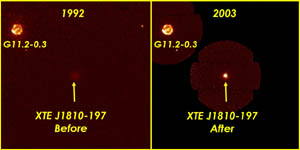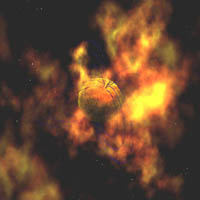Imagine the Universe News - 28 January 2004
A Neutron Star Emerges As A Rare Magnetic Emerald
| 28 January 2004 |
Sometimes astronomers look in the right place at the right time, and that's just what happened in July 2003.
A group of astronomers at NASA's Goddard Space Flight Center were, by chance, looking in just the right place and saw a neutron star emerging from a metamorphosis.� The star was shedding its dim, nondescript existence of millions of years and suddenly transformed itself into a bright and exotic object called a magnetar.�
Only ten magnetars are known in the whole Universe.� So this was a real gem of a find.
These magnetars are a class of ultra-magnetic neutron stars.� Their magnetic fields are so strong that they could strip an electronic gift card clean at a distance of 100,000 miles, or half way to the Moon.� Where do they come from, and how do they get so magnetic?� These are two questions that the lucky observation will help answer.
Neutron stars are scattered throughout our Milky Way galaxy and in billions of other galaxies too.� These are fascinating objects in their own right.� A neutron star is created in a type of star explosion called a supernova, and� contains the mass of the Sun compacted into a sphere only about 10 miles across.
Neutron stars are very magnetic.� They have a magnetic field strength of a billion to a trillion Gauss.� In comparison, the Earth's magnetic field is about 0.5 Gauss, and a refrigerator magnet is about 10 to 100 Gauss.� Magnetars are a thousand times more magnetic than neutron stars, about a hundred trillion (1014) Gauss.
Dr. Alaa Ibrahim led the discovery of the new magnetar, which he and his colleagues called XTE J1810-197.� Part of the name comes from the instrument that spotted the magnetar, NASA's Rossi X-ray Timing Explorer.�
 |
|
An image showing side by side comparisons before and after the event. (Credit: NASA) (Click image for high resolution version.) |
What's interesting is that Dr. Ibrahim was studying another magnetar at the time.� Caught in this "routine" observation was a strange, new bright object.� He thought it might have been a magnetar because it was so bright.� Magnetars are very energetic, and they radiate in X rays.�
Dr. Ibrahim's colleagues, including Dr. Craig Markwardt and Dr. Eric Gotthelf, pinpointed the location of the new source.� No one had seen it before.� They then poured through archived data from past missions.� Sure enough, looking closely in the old data back to 1990, they saw a very dim neutron star in the exact spot where the new magnetar is.� This magnetar must have "turned on" between January and March of 2003.�
The observation supports one theory of magnetars.� Some scientists think that about 10 percent of neutron stars are born with ultra-high magnetic fields.� This might be because of the mass of the progenitor star or the spin that the neutron star gets from the explosion.� Such neutron stars sit unnoticed, extremely dim because they have no fuel to burn.
Gradually, the magnetic field slows the spin of the neutron star.� This act of slowing releases energy, making the star brighter.� Additional disturbances in the star's magnetic field and crust (called starquakes) can make it brighter yet.� This is when it reaches the magnetar stage.� The original neutron star was also very magnetic, but that field simply couldn't be measured from afar until the star got bright.� To measure a magnetic field, scientists use an equation that compares the speed of the neutron star spin to the rate that it is slowing down.� When a star is dim, scientists can't gather this information.
So, magnetars might start out magnetic but dim (at this point, it might be called a regular neutron star, or maybe it isn't visible at all).� Then, after existing for tens to hundreds of millions of years like this, it gets bright -- the magnetar stage.� Then, the magnetic fields weaken and the star gets dim again.� The magnetar stage may be but a brief moment of beauty in the billion-year existence of special neutron star.
This would explain why scientists have only found 10 magnetars so far.� There could be many more out there simply in prolonged dim stages.� To confirm this theory, scientists will need to find many more magnetars turning on.
In the future, they may not need to be so lucky.� Along with the Rossi Explorer, which is still going strong after 9 years in orbit, scientists will soon have the Swift Gamma-ray Burst Explorer in orbit.� Although Swift's primary goal is to detect gamma-ray bursts, the observatory will also likely find magnetars.� This is because Swift will be good at spotting transient events, that suddenly appear in its field of view.
Other members of Dr. Ibrahim's team are Dr. Jean Swank of NASA Goddard; Dr. William Parke of George Washington University; Drs. Scott Ransom, Mallory Roberts and Vicky Kaspi of McGill University; Drs. Chryssa Kouveliotou and Peter Woods of NASA Marshall; Dr. Samar Safi-Harb of the University of Manitoba; Dr. S�len Balman of the Middle East Technical University in Ankara; and Dr. Kevin Hurley of University of California at Berkeley.� Dr. Ibrahim has a joint position with George Washington University.


